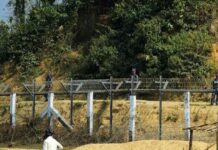
Sirajul Haque Khan cannot recall the last time someone came to check the gas connection to his building.
In fact, the 73-year-old businessman in Pargandaria of Jatrabari never saw any official to inspect the gas lines in his neighbourhood in the last 39 years since he started living there.
“All these years, people from the city corporation worked several times to upgrade the sewage line but we did not see anyone coming from Titas gas for checking or upgrading the gas connections,” said Sirajul.
“We only see their movements after a tragic incident caused by gas leaks.”

Despite being the country’s biggest gas transmission and distribution company with 60 percent share of gas connections, Titas does not have any mechanism to identify any leakage from its vast network of underground gas pipelines.
And the actions the Titas officials take after such events are not prompt enough, forcing customers to turn to local plumbers to fix the problems, allege a number of customers.
Energy experts said such complaints have been a common phenomenon over the years and it only speaks how badly Titas maintains its transmission and distribution lines.
They think the frequent fire incidents and the last month’s blast in a Narayanganj mosque were the outcome of negligence and mismanagement over the years from the country’s biggest natural gas distributor and its supervising authorities.
A SAGA OF NEGLIGENCE
Titas Gas Transmission and Distribution Company Limited has 13,138km underground pipeline, 624km transmission and 12,514km distribution or service lines, in its network that covers Dhaka, Narayanganj, and Gazipur.
It has around 28.66 lakh domestic and industrial consumers.
Of the total service line, 7,001.40km was constructed by the end of the year 2000, according to official documents of Titas. It’s longest service line is around 6,000km, which is in Dhaka.
Titas officials said around one third of the total gas pipeline, installed 25-40 years ago, has become rusty and risky. The problem is mostly with the distribution line.
The company has a dedicated section called System Operation Department for maintenance. But it mainly depends on consumer’s complaint in the absence of a mechanism or device to identify the leaks without seeing it physically.
For lodging complaints, it has a call centre which receives on an average 375 emergency and 50 normal calls a month, according to an official.
Surprisingly, Titas does not have the detailed service line map and central database for replaced pipelines.
“We don’t have the exact data on leaks in gas distribution lines right now,” Titas Managing Director Ali Md Al-Mamun told The Daily Star.
However, a survey conducted by Titas three years ago found 35,000 out of its 5.65 lakh gas risers leaky.
Risers are used to bring buried natural gas piping above the ground to allow access to the gas flowing through the pipes.
A Titas official concerned said there was no data on risers being fixed so far.
The poor condition of the gas transmission and distribution infrastructure was highlighted in the Power Sector Masterplan (PSMP)-2016, prepared by Japan International Cooperation Agency (JICA).
As a short-term goal, the PSMP-2016 recommended that transmission and distribution should be electronically mapped to introduce advanced monitoring and control systems to support efficient use of gas by 2019.
On the gas leak incidents, it said most of the incidents presumably are caused by poor maintenance, use of low-grade materials, and/or poor construction practice.
“More attention should be given to gas leaks and system loss from gas transmission and distribution infrastructure to prevent economic loss, i.e. the lost opportunity cost,” it added.
Four years have gone by since the PSMP-2016 came up with the recommendations but nothing has changed in the field of operations and maintenance, said energy experts.
The government mainly focused on power generation using expensive fossil fuel, they said, adding that due to poor maintenance and operation, gas-related fire incidents are taking place frequently, leading to casualties.
According to the Fire Service and Civil Defence Directorate, there were 24,074 fires last year.
“We found 19 percent accidents were gas-related, gas leakages to be precise,” said Brigadier General Md Sazzad Hussain, director general of the directorate.
Titas claimed 208 fires in 2018-2019 in its distribution areas gas-related.
‘AN ENEMY OF THE MASSES’
Prof Badrul Imam of Dhaka University pointed to two factors: use of poor-quality raw materials in illegal connections and no effort to replace the old pipelines.
Terming the network of illegal gas lines nothing but a time bomb, he said it is the creation of Titas officials who are “more interested in corruption than providing service”.
“They are not accountable. The illegal network of gas pipelines is their creation. Unless Titas stops their illegal activities, accidents will continue to happen.”
Prof Badrul suggested that the government makes alternative fuels like LPG cheaper, even if it requires subsidy, to shed the burden on pipeline gas.
On the graft among Titas officials, Prof M Shamsul Alam, energy adviser to Consumers Association of Bangladesh (CAB), said, “People are suffering just due to the greed of those corrupt officials. Titas has turned into an enemy of the masses.”
“We have to bribe them to fix the leakages and pay extra charge due to the rise in gas price. They are providing poor quality gas but feasting on illegal networks.”
He claimed there are 70,000 points in Dhaka city where gas leaks due to poor maintenance and illegal connections.
M Tamim, a teacher of Bangladesh University of Engineering and Technology, thinks the main problem of Titas is in its management.
“Illegal gas connections, gas line leakage, corruption — all are interrelated. If there is corruption, there will be illegal connections,” said Tamim, also a former adviser to a caretaker government.
SHIFTING BLAME
Titas Managing Director Ali Md Al-Mamun blamed other service providers, including city corporations and Wasa, for damaging and cracking its pipes during their development activities.
“In most cases, when other service providers work, they unintentionally make some leaks,” he said.
“I have already issued instruction to identify all the gas-leaking points and repair those within a month.”
Rana Akbar Haidary, director operation of Titas, said, “A number of development work like metro rail is going on in the Titas gas transmission area, causing a good number of leaks. But some leaks happened automatically.”
State Minister for Power, Energy and Mineral Resources Nasrul Hamid said most of the Dhaka city lines are old and need to be replaced.
There are around 700km of illegal gas pipelines across the country, he said without elaborating further.
“Of course, Titas has responsibility and they will be punished for any negligence on their part. But Titas also cannot do everything. What about the other service providers? We all have to work together,” he said.
The minister said the government has taken up a Tk 1,200 crore project for replacing the old pipelines to streamline the gas distribution system.
Under the project, the gas transmission and distribution system will come under Supervisory Control and Data Acquisition (SCADA) system.
Once the SACDA system is introduced, information of a leak in a gas line or an illegal connection at any place will immediately go to the central control room, said Nasrul.









